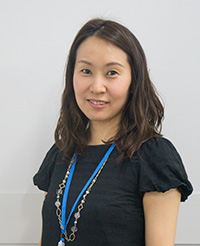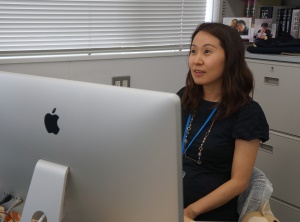Jul. 24, 2015
Witnessing the birth of a star
Nami Sakai, Associate Chief Scientist

Star and Planet Formation Laboratory , Associate Chief Scientist Laboratories
Please describe your current research.
I study the formation of stars and surrounding protoplanetary disks of dense, rotating dust and gas using state-of-the-art radio telescopes from around the world. These early events in interstellar space eventually develop into the planets, asteroids and comets that make up a solar system. By analyzing the structural and chemical evolution of one of the most fundamental processes in the Universe, I hope to gain an understanding of the origins of our Solar System, and eventually, the origins of life on Earth.
How did you become interested in your current field of research?
When I was in elementary school, my father showed me the craters on the Moon through a telescope. That inspired me to study outer space and find out how stars are born. I decided to major in physics and joined a laboratory that focused on stellar nurseries, known as molecular clouds, and their chemical evolution. That was when I set myself a concrete goal of learning about the chemical origins of the Solar System, and whether it is unique or universal. I also hope to nurture young researchers who will continue to answer these questions for years to come.
What excites you the most about your current research?
There are so many things that we still do not understand—this is true of almost every field, but especially of astronomy. Our research typically involves making predictions about cosmic phenomena and then using telescopes to verify these predictions. More often than not, the results are completely unexpected. When that happens, it is exciting to realize that you are the only person in the world to know the unexpected nature of the Universe at that moment in time, and to imagine what effect it will have, if it turns out to be true, on subsequent research.
What has been the most interesting discovery in your field in recent years?
The discovery of hollow molecules of carbon called fullerenes in space, including spherical buckyballs (C60), though this finding has had little bearing on my own research.
How has being at RIKEN helped your research?

I joined RIKEN in April 2015 as an associate chief scientist. Unlike at a university, we don’t have any teaching obligations at RIKEN and can therefore concentrate on our research. We can conduct our research freely, without being restricted by the boundaries between different research fields, such as physics and chemistry. One day, for example, I happened to run into an old friend of mine from my high school days who is a researcher on the same campus at Wako city, near Tokyo. Even though he came from a different research field, we started conducting joint seminars, which made me realize how interdisciplinary RIKEN really is.
How do you balance family life with your work at RIKEN?
Whenever possible, I avoid working late and on holidays, and I try to spend time with my family. I don’t have many rigidly scheduled commitments such as classes, so it is relatively easy for me to take time off if my son comes down with a fever, for example.
